| NAPOLEON AVENUE UNITED METHODIST CHURCH |
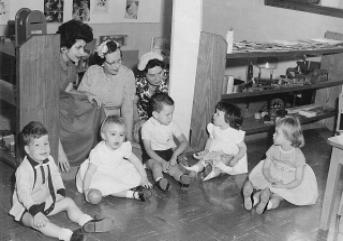
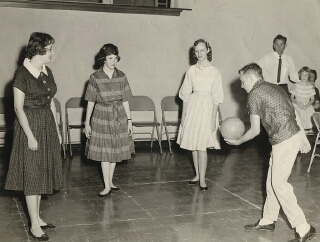
| My mother, Florelle Garrett Jackson, the lady in the center, was a Sunday school teacher at Napoleon Avenue Church for many years; I don't know the names of the other ladies in this photo, but I believe the child on the far left, is Ford Willoughby, III. |
| Methodist Youth Fellowship meeting; left to right: Ruth-Anne Hoffstadt, Donice Alverson, Nancy Jackson and Jimmy Shelby |
| The link to this page is: http://old-new-orleans.com/NapoleonChurch.html Back to Old New Orleans Whispers - Home |
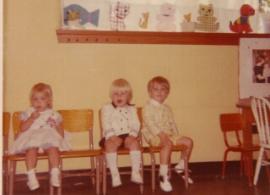
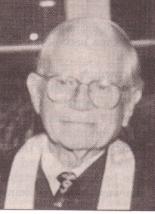
| Sunday School Classes Photo on left: my son, Jim Brister, is on far right. Unfortunately, I don't know the names of the other children in these pictures, or the names of the teachers in the photos below. |
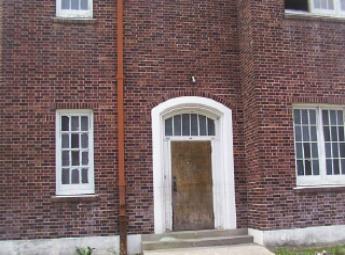
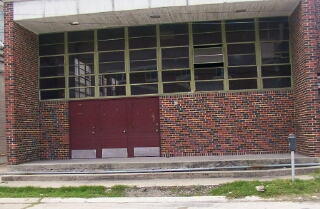
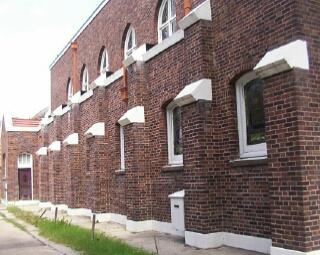
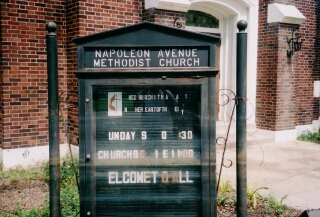
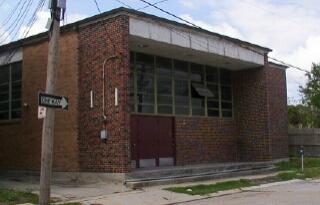
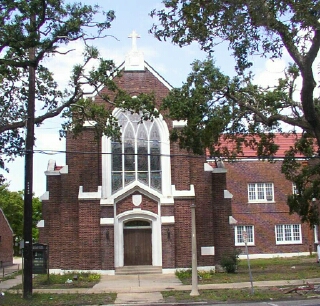
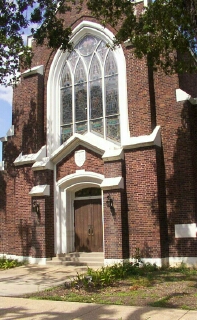
| I took the photos below in July, 2006. |
| Seldom has a youngster had a spiritual advisor and role model as excellent as Rev. Alverson. It was with great sadness that I read of his passing. He had evacuated from his home in the Lake Vista neighborhood of New Orleans in advance of Hurricane Katrina and that section of the city was badly flooded. He was still in southwest LA when he died four months later. It can be said of him that he made a difference. ~~~~~~~~~ Rev. Donice Alverson, retired pastor, activist Tuesday, January 31, 2006, The Times-Picayune The Rev. Donice Watson Alverson, a retired Methodist pastor and civic activist, died Thursday at St. Elizabeth's Hospital in Gonzales, where he evacuated because of Hurricane Katrina. He was 86. Pastor Alverson was born in Flat Rock, Alabama and moved to New Orleans in 1956. He graduated from the Candler School of Theology at Emory University. He gave up plans to pursue a doctorate of divinity at Boston University to accept the post of pastor to the Epps-Pioneer circuit of rural churches in northeast Louisiana. Pastor Alverson served as pastor of Sevier Memorial Methodist Church in Ferriday from 1950 to 1956 and was active in the anti-Gov. Earl Long movement. He also campaigned against corruption in Gov. Robert Kennon's administration and opposed U. S. Sen. Joseph McCarthy's anti-Communist hearings. In 1956, Pastor Alverson became pastor of Napoleon Avenue Methodist Church. He was active in the spiritual lives of local students and was an outspoken desegregation advocate, preaching the need for compassion and opening his congregation to people of all races. He went on to serve as pastor of Lake Vista United Methodist Church from 1972 until he retired in 1987. Pastor Alverson also was the Protestant chaplain at Southern Baptist Hospital for many years, and served as a minister of visitation at First Methodist Church in New Orleans as well as a guest preacher at local churches. He was an Air Force veteran of World War II. Survivors include his wife, Jewell West Alverson, two daughters, Donice Alverson and Margaret Alverson, a brother, Robert Alverson of Birmingham, AL, a sister, Mirial Alverson Lowe of Florence, AL and six grandchildren. |
| In the years when my mother and I attended, there were many descendants of the original German members who were still there: the names Kriege, Hoffstadt, Kuhnell, Kuenstler, Hinrichs and Meyers come to mind. A flood of memories comes, as well: Homecoming Day picnics on the lawn; Methodist Youth Fellowship meetings in the Recreation Building---where I met the first boy I ever dated---and where my friend, Mary Clare, would so often join me, favoring the MYF meetings over her own CYO meetings a block down the street, at St. Matthias Catholic Church; Sunday morning services in the sanctuary, watching, mesmerized, as the sun streamed through the beautiful stained glass windows; Sunday evening services, when, during Mardi Gras season, our much loved minister, Rev. Don Alverson, would bring his sermon abruptly to an end as soon as he heard the familiar police sirens announcing the arrival of the night parade on Freret Street, a block away; gathering on the lawn with other church members on Mardi Gras day to watch King Rex come down Napoleon Avenue and the "picnic" lunch spread out in the Recreation Building for everyone to share; a tapestry of christenings, weddings, funerals; the friends I knew so well, both mine and my mother's---their stories, their lives, their faith. Memories are precious things. ~ ~ ~ ~ ~ Unfortunately, the church sustained heavy interior damage because of the levee failures, but it is structurally sound and, thankfully, the stained glass windows survived. The future of the church is in doubt. 9/2007: I'm sorry to say that the United Methodist Church has made the decision to decommission Napoleon Avenue Church. I've heard from Rev. Alverson's daughter, Donice, who let me know about the conference's decision. As far as I know, no announcement has been made regarding the fate of the buildings. This is very sad news. |
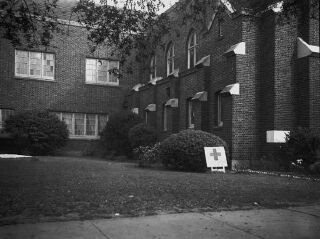
| This photograph was taken during World War II, when Napoleon Church was used as a Red Cross Center; photo by Alexander Allison. |
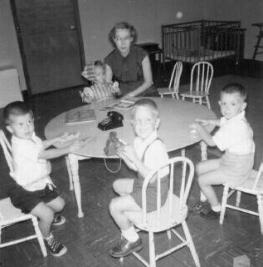
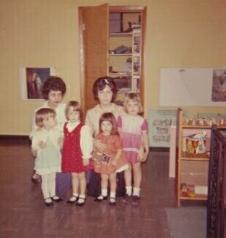
| After the levee failures of 2005 heavily damaged the church's interior, the United Methodist Church made the decision to sell Napoleon Avenue Church. I received a message from one of the members of a mission team who had come to New Orleans to help renovate the buildings for the new owners -- the congregation of All Nations Fellowship, an Assembly of God church. He told me that the Methodist Church had retained the beautiful stained glass windows (except the one at the rear of the sanctuary--which would be the front of the building, the window that can be seen in the photo on the right). He was kind enough to share photos he'd taken of the church. I'm trying to find out if or where the stained glass windows have been placed; if you know, I'd appreciate hearing from you. Go to the bottom of the page for some pictures of the church taken during the renovation. Nancy |
| The photographs below were kindly shared by Ryan Johnson, taken during the renovation of the church after it was sold in 2008. For those of you not familiar with renovations following a flood, it's not only the damage that occurs from the flood waters, but from the mold that quickly accumulates in the conditions before and after the flood waters recede. The water was about 4 feet deep, but all of the walls, floor to ceiling, had to be stripped, treated and repainted. It's hard to imagine from these photos, but the sanctuary was once very beautiful. Now, thankfully, it will be again. |
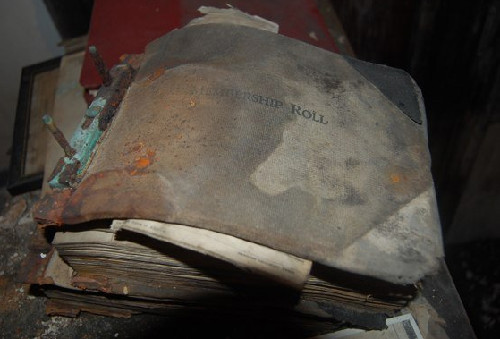

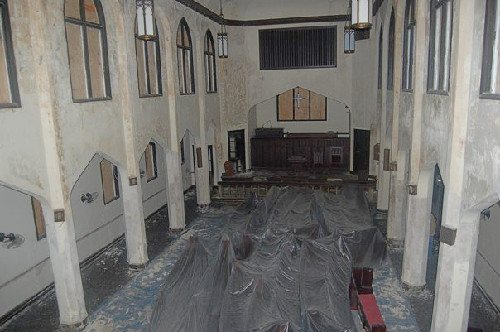
| The only original stained glass window remaining in the sanctuary. |
| Taken from the rear choir loft looking toward the pulpit. |
| I don't know if they would have been salvageable, but I'm amazed that the Napoleon congregation didn't attempt to save the historic membership roll books...it looks as if everything in the church office was just left there. |
| I believe the organ may still be in the choir loft behind the pulpit, but it's difficult to tell. I wonder if it can be salvaged. I've been told that it was one of the finest in the city. |
| Left, the stairs in the sanctuary building; above, looking toward the rear of the church. The mahogany pews are still there and, since they're being protected, apparently, will be used. |
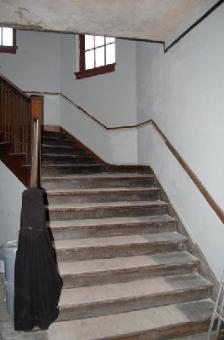
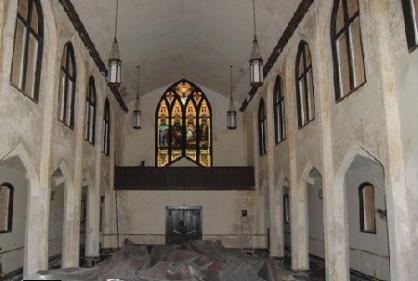
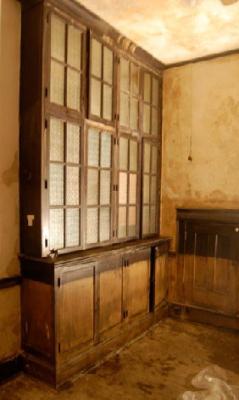
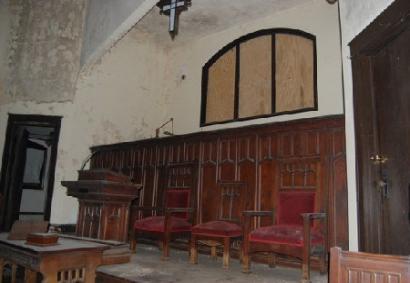
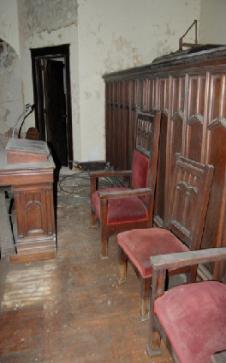
| Left & above, a Sunday school room in the sanctuary building. I believe the room with the fireplace was the Emma Kriege Bible Classroom. Below, one of the pictures that was left behind. |
| Right, a photo of the volunteers. I'm so grateful that the building was purchased and spared. I hope the new congregation will flourish and enjoy many years there. ~ ~ ~ However, it will always be Napoleon Avenue Methodist Church to me. And the ghosts of the good folks who loved the old church for so many years will continue to gather on Sunday mornings and take their places in their regular pews. |
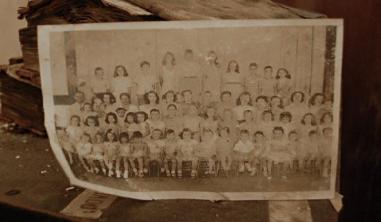
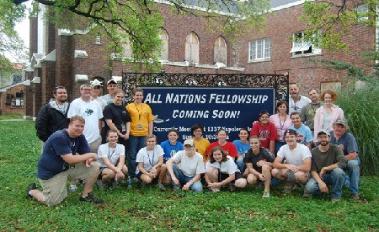
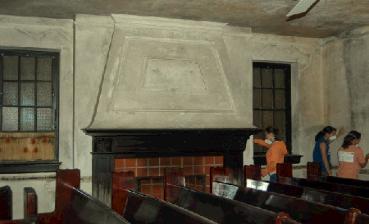
Napoleon Avenue United Methodist Church is the church in which I was confirmed and where my
son, Jim, was Christened. I was ten years old when my mother and I started attending this lovely
old church in the heart of the city ("The church with a heart, in the heart of the city") and remained
an active member for about twenty years. (See photos below.)
The church was founded by German immigrant, Rev. Peter Schmucker, in the early 1840's. Rev.
Schmucker had traveled to New Orleans specifically to establish German Methodism in the city. He
bought property on Erato Street and a church was built and in 1843, Rev. Carl Bremer was
appointed as the first pastor of the First German Methodist Church. About a dozen years later, a
new church was built on Dryades Street and replaced by another building in approximately 1860. A
dozen years later, yet another church building was erected on Franklin Street and, a few years
later, they merged with the congregation of the St. Charles Avenue Methodist Church.
Requiring larger facilities, the church purchased property on Napoleon Avenue in 1920. Two years
later, the new church, which is the building still in use today, was completed. It was dedicated on
January 7, 1923. The Meyers family, prominent members of the church, donated a large portion of
the $120,000 cost of construction.
Among the building's most impressive features are the beautiful stained glass windows and a
Moeller pipe organ with more than 500 pipes. I have yet to see stained glass windows more lovely
than the ones in the sanctuary of Napoleon Avenue Church.
son, Jim, was Christened. I was ten years old when my mother and I started attending this lovely
old church in the heart of the city ("The church with a heart, in the heart of the city") and remained
an active member for about twenty years. (See photos below.)
The church was founded by German immigrant, Rev. Peter Schmucker, in the early 1840's. Rev.
Schmucker had traveled to New Orleans specifically to establish German Methodism in the city. He
bought property on Erato Street and a church was built and in 1843, Rev. Carl Bremer was
appointed as the first pastor of the First German Methodist Church. About a dozen years later, a
new church was built on Dryades Street and replaced by another building in approximately 1860. A
dozen years later, yet another church building was erected on Franklin Street and, a few years
later, they merged with the congregation of the St. Charles Avenue Methodist Church.
Requiring larger facilities, the church purchased property on Napoleon Avenue in 1920. Two years
later, the new church, which is the building still in use today, was completed. It was dedicated on
January 7, 1923. The Meyers family, prominent members of the church, donated a large portion of
the $120,000 cost of construction.
Among the building's most impressive features are the beautiful stained glass windows and a
Moeller pipe organ with more than 500 pipes. I have yet to see stained glass windows more lovely
than the ones in the sanctuary of Napoleon Avenue Church.